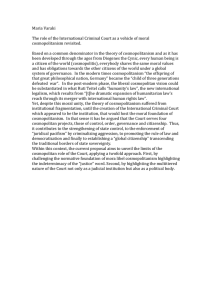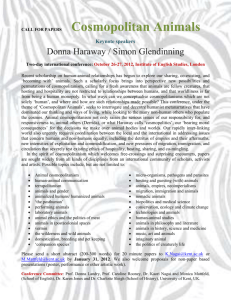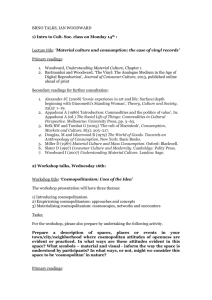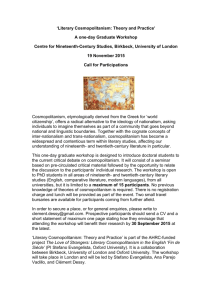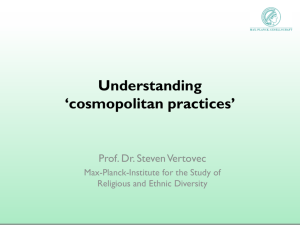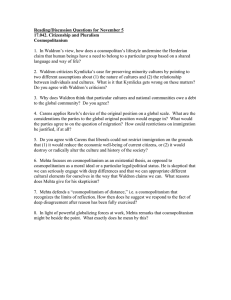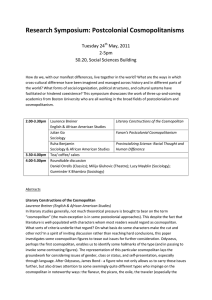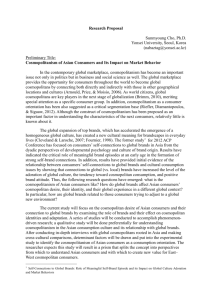Introduction
advertisement
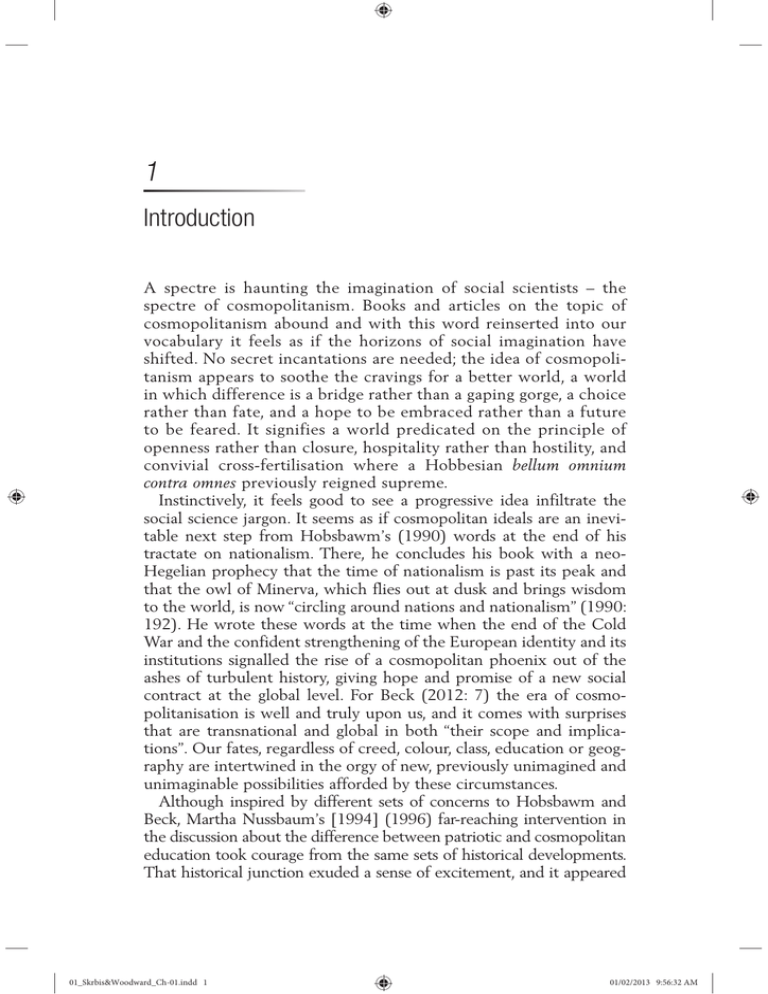
1 Introduction A spectre is haunting the imagination of social scientists – the spectre of cosmopolitanism. Books and articles on the topic of cosmopolitanism abound and with this word reinserted into our vocabulary it feels as if the horizons of social imagination have shifted. No secret incantations are needed; the idea of cosmopolitanism appears to soothe the cravings for a better world, a world in which difference is a bridge rather than a gaping gorge, a choice rather than fate, and a hope to be embraced rather than a future to be feared. It signifies a world predicated on the principle of openness rather than closure, hospitality rather than hostility, and convivial cross-fertilisation where a Hobbesian bellum omnium contra omnes previously reigned supreme. Instinctively, it feels good to see a progressive idea infiltrate the social science jargon. It seems as if cosmopolitan ideals are an inevitable next step from Hobsbawm’s (1990) words at the end of his tractate on nationalism. There, he concludes his book with a neoHegelian prophecy that the time of nationalism is past its peak and that the owl of Minerva, which flies out at dusk and brings wisdom to the world, is now “circling around nations and nationalism” (1990: 192). He wrote these words at the time when the end of the Cold War and the confident strengthening of the European identity and its institutions signalled the rise of a cosmopolitan phoenix out of the ashes of turbulent history, giving hope and promise of a new social contract at the global level. For Beck (2012: 7) the era of cosmopolitanisation is well and truly upon us, and it comes with surprises that are transnational and global in both “their scope and implications”. Our fates, regardless of creed, colour, class, education or geography are intertwined in the orgy of new, previously unimagined and unimaginable possibilities afforded by these circumstances. Although inspired by different sets of concerns to Hobsbawm and Beck, Martha Nussbaum’s [1994] (1996) far-reaching intervention in the discussion about the difference between patriotic and cosmopolitan education took courage from the same sets of historical developments. That historical junction exuded a sense of excitement, and it appeared 01_Skrbis&Woodward_Ch-01.indd 1 01/02/2013 9:56:32 AM Cosmopolitanism that the time for the reintroduction and blossoming of the idea of cosmopolitanism finally arrived, albeit well over two thousand years after its birth, when Diogenes of Sinope (b. 412 BC) announced: ‘I am a citizen of the world’. Diogenes’ statement lends itself to multiple interpretations, but there is no doubt that it represented a radical departure from the thinking prevalent in his time. It cogently professes a degree of detachment from the immediate political and cultural context as well as proposing a sense of openness towards the universal. The term cosmopolitanism is increasingly commonly used, yet it continues to escape easy definition. Philosophers and sociologists alike find it notoriously difficult not only to define the term but also to agree on just who befits the label ‘cosmopolitan’. We understand and are sympathetic to the definitional complexities around cosmopolitanism, but as sociologists we cannot accept that an agreement on the attributes of ‘cosmopolitan’ is so elusive that engagement becomes pointless. We suggest that there are four basic dimensions of cosmopolitanism that can easily be accepted: the cultural, political, ethical and methodological. Cultural dimension. We concur with Nussbaum (1996) that there are different ways of being cosmopolitan, but what most cosmopolitans share is a disposition of openness to the world around them. We once apologetically remarked that this emphasis on openness is likely to sound nebulous and trite, but there is little doubt that a disposition of openness is a basic philosophical posture underpinning cosmopolitanism and a basic dispositional characteristic that most theorists of cosmopolitanism agree on (Skrbiš and Woodward, 2011). We find it at the point of its origin in Diogenes. We also find it in Kant’s (1795, ed. 1983) classical conception of peace and hospitality. More recently, it was a central component to Nussbaum’s (1996) argument about education which, in her view, must be inherently international and cosmopolitan in orientation. The conception of openness is for us an epistemological principle of cosmopolitanism: it limits and fixates the definitional horizon by reminding us that beyond openness lies a sphere of all things un-cosmopolitan. Political dimension. Cosmopolitan commitment is also a political commitment, which encourages us to appreciate and recognise difference, embed our politics in universal principles and commit ourselves to the dethronement of one’s unique cultural identity. This dimension extends into institutional and global domains when cosmopolitan political commitments aim beyond the local and particular and morph into institutionally committed cosmopolitan principles. At this global level cosmopolitanism refers to 2 01_Skrbis&Woodward_Ch-01.indd 2 01/02/2013 9:56:32 AM Introduction an ambition or project of supra-national state building, including regimes of global governance, and legal-institutional frameworks for regulating events and processes, which reach beyond any one nation. Examples of this include the United Nations, the European Union and various regional political alliances – all imperfect, but nevertheless committed to more universal forms of governance that are driven by notions of common good. Ethical dimension. This dimension is integral to cosmopolitanism in all its forms and is defined by an inclusive ethical core that emphasises worldliness, hospitality and communitarianism. In this book we will specifically address the question of cosmopolitan ethics in relation to two highly controversial social phenomena. The first relates to the way in which refugee issues are currently being dealt with. This case is instructive because it goes to the very core of the notion of hospitality towards strangers and how cosmopolitan openness is tested in practice. The second relates to a symbolically contested discussion about the veil in western democracies. Methodological dimension. Because the cosmopolitan perspective seeks to extend social analysis beyond national borders and frameworks – and in particular, to analyse the fluid, relational and mobile aspects of social life on a continuum from the local to the global – some cosmopolitan theorists argue that a new type of social analysis is required. At its core is an argument which is not necessarily about the rejection of the nation-state’s importance and relevance, but rather the embrace of a post-national and transnational perspective in understanding the forces of globality. The political and practical relevance of this move to become ‘methodologically cosmopolitan’ is that social analysis opens up to the relational processes which bind local and global, universal and particular, familiar and other. The result, it is hoped, is a social science which is better attuned to accurately describe the processes which form and structure the global world. These four dimensions of cosmopolitanism are closely intertwined and we distinguish them for heuristic purposes only. In practice they are largely inseparable and this complex interdependence makes them an exciting sociological project. The accent here is on the idea of cosmopolitanism as a project. Cosmopolitanism is not a state of nirvana; it is not an endpoint of societal affairs. It is an ongoing effort of incorporation of cosmopolitan ambition through all its dimensions. Cosmopolitanism has traditionally been conceived as embodying positive attributes which range from simple displays of openness to active embracing of diversity and otherness. But it was not always so. Hitler used the term cosmopolitan as a shortcut for the kind of people 3 01_Skrbis&Woodward_Ch-01.indd 3 01/02/2013 9:56:33 AM Cosmopolitanism who he perceived as not befitting his racial and political ideals. In the late 1940s, Stalin’s regime initiated extensive anti-cosmopolitan campaigns and it saw cosmopolitanism as representing hostile bourgeoisliberal stances towards the Soviet regime, mixed with anti-Semitic and anti-Western rhetoric (Azadovskii and Egorov, 2002). But a generally positive, liberal and normative undertone is what causes the idea of cosmopolitanism to easily put one under its spell. Despite assurances to the contrary and anti-evangelical disclaimers, the proponents of the idea of cosmopolitanism often succumb to its normative promise, cleansed of the impurities of real life and projected as a shining example of human hope and universal fraternisation. It is the inherent seductiveness of the idea of cosmopolitanism that attracts a diverse range of interpretations and readings and encourages its proponents to spread the cosmopolitan imagination’s wings. As we stated elsewhere about cosmopolitanism, “Its Stoic parentage, Kantian upbringing and postmodern spoiling have made it a robust but somewhat confused adolescent” (Skrbiš et al., 2004: 115). Normative appropriations of a concept are not necessarily a bad thing. We know all too well that good ideas often thrive when going through an imaginative reframing of what has always been thought of as impossible or unchangeable. Yet, this unfortunately also serves as an excuse for many a cosmopolitan theorist to use the concept as if it were an elastic cord which can be stretched in every possible direction. There has been an explosion of literature on cosmopolitanism over the past 20 or so years and the discussion has been vibrant and exhilarating as well as frustratingly self-indulging. The idea has been subjected to an avalanche of unprecedented ‘adjectivisation’ which has added spin to the idea of cosmopolitanism, but which has not necessarily advanced our understanding of it. While there is no doubt that different types of cosmopolitanism are observable, and that colourful adjectives added to the concept can be useful, the smorgasbord of cosmopolitan conceptual choices could at times be likened to a rich dish seasoned with competing and irreconcilable spices. Our own cursory review of adjectival enthusiasm revealed the following cosmopolitan attributes mentioned (not necessarily authored) in various sources: ordinary, practical and everyday (Lamont and Aksartova, 2002), vernacular (Bhabha, 1996), discrepant and comparative (Robbins, 1998), actually existing (Malcomson, 1998), working class (Werbner, 1999), moral, political, legal, cultural, economic and romantic (Kleingeld, 1999), minoritarian (Pollock et al., 2000), nativist (Kaufmann, 2001), everyday (Vertovec and Cohen, 2002), capitalist (Vertovec and Cohen, 2002: 314), mundane 4 01_Skrbis&Woodward_Ch-01.indd 4 01/02/2013 9:56:33 AM Introduction (Szerszynski and Urry, 2002), casual (Gable, 2002), vernacular, rooted, critical, comparative, national, discrepant, situated (Hollinger, 2002), queer (Rushbrook, 2002), rural, plebeian, patrician (Gidwani and Sivaramakrishnan, 2003), gay (Binnie and Skeggs, 2004), pop (Jenkins, 2004), über- (Skrbiš et al., 2004), reluctant (Swetschinski, 2000), banal and reflexive (Beck, 2006), anti- and counter (Appiah, 2006), weak (Miller, 2007), vertical and horizontal (Beck and Grande, 2007), intimate (Mitchell, 2007), nationalist (Malachuk, 2007), feminist (Werbner, 2008), dedicated and pragmatic (Weenink, 2008), Aboriginal, anti-colonial, anti-imperial, anti-proprietary, emancipatory, feminist, from below, marginal, migrant, minority, NGO, nonelite, oppositional, popular non-Western, vernacular, working class, minoritarian and subaltern (Holton, 2009), political, identity, personal and commodified (Radice, 2009), Davos, Benetton, frequent flyer, imperial and dialogical (Mendieta, 2009), hipster (Roberts, 2009), instrumental (Ong, 2009), culinary (Johnson and Baumann, 2009), carnival and colonial (Skinner, 2010), eco- (Barbas-Rhoden, 2011), and then a host of other adjectives such as non-elite, one world, imperial, patriotic, discrepant, multicultural, left, consumerist, soft, attenuated and comparative. The list does not stop here. Not surprisingly, when reviewing the literature on cosmopolitanism, Mendieta (2009: 241) noted that it resembles “the veritable ruins of a tower of Babel”. This plurality and variability of cosmopolitanisms is useful although one can hardly blame naïve outsiders for remarking that writers on cosmopolitanism have more than their fair share of fun in linguistic wizardry and creativity. It also opens up perhaps uncomfortable debates about the extent to which a creative impulse pervading discussions of cosmopolitanism actually correlates with substantive and programmatic progress in cosmopolitanism research. We refute any suggestion that our discomfort with conceptual inflation in cosmopolitanism research is a sign of an early onset of our middle-aged sociological neurosis, although we do admit preference for conceptual clarity. Nearly a decade ago we concurred with Himmelfarb’s (1996: 77; quoted in Skrbiš et al., 2004: 115) ironic observation that the idea of cosmopolitanism has “a nice, high-minded ring to it”. Yet, we also added that a concept that sounds good and makes a good promise “does not necessarily make a good analytical tool”. The inflatory tendencies in the cosmopolitanism lexicon show no sign of abating. To make things worse, one can note with increased frequency a tendency to conflate terms such as multiculturalism and cosmopolitanism without actually spelling out the difference between 5 01_Skrbis&Woodward_Ch-01.indd 5 01/02/2013 9:56:33 AM Cosmopolitanism the two. Whilst multiculturalism and cosmopolitanism are likely to have much in common, we feel that they nevertheless depict ontologically different states of social dynamics. And, we hasten to add, if they are no different then we either have one concept too many or we are unclear about the reality we are trying to explain. Slipping in and out of these concepts without critical reflection is like slipping in and out of a coma: it can’t be good for you. About the Book This is not to say that cosmopolitanism research is all doom and gloom. We confidently credit the writing in the cosmopolitanism literature over the past 20 years with some novel and exciting ways of imagining people, culture and societies. In this book we intend to provide an accessible perspective on what we feel are the most important premises which characterise the contemporary cosmopolitanism research field. We shall also look to new developments and social arenas to show how the idea of cosmopolitanism can be applied in grounded and real-world settings. We will do this by acknowledging the enormous scale of work that has been generated, but leaving out – as much as possible – noisy details that may tempt us to focus on a detail where a broad brush approach could be more informative. The chapters which follow will be organised around three of the previously identified substantive dimensions of cosmopolitanism: cultural, political and ethical. The introductory chapter of the book discusses the re-emergence of cosmopolitanism in the social sciences and the explosion of variations and adjectives that illustrate its broad usage and the range of topics it is applied to in contemporary times. In it, we also outline how the book then takes readers on a journey from exploring what is meant by cosmopolitan identities, via the high ideals and legal-structural application of cosmopolitanism at the level of citizenship and ethics, the power and influence of global networks in fostering cosmopolitanism, and finally on to more accessible aesthetic and sensual forms such as mediated forms of cosmopolitanism in the media and cultural institutions like museums and galleries. Finally, we bring our examination of cosmopolitanism right down to the messiness of human life, where the focus is on ordinary cosmopolitanism and everyday cosmopolitan encounters. In Chapter 2, we focus on the definition and formation of the cosmopolitan identity. The idea of cultural ‘openness’ has been a wellspring for general conceptions of cosmopolitanness as an outlook or disposition possessed by individuals. Most contemporary literatures identify the cosmopolitan individual as having a distinctive set of attitudes and a 6 01_Skrbis&Woodward_Ch-01.indd 6 01/02/2013 9:56:33 AM Introduction discernible corpus of practices which value cultural difference. While some see this type of cosmopolitanism as potentially dangerously associated with privileged forms of cultural appropriation, this type is generally seen as beneficial. However, the label ‘cosmopolitan’ has not always been used as endorsement. Currently, the term is generally seen is a positive light, emphasising diversity, hybrid formations, privileged mobility and cultural intermingling, but there have also been historical eras where the term has been largely pejorative, suggestive of moral and ethnic inferiority. This chapter interrogates the different meanings of cosmopolitanism as it is held and practiced by individuals and asks whether there are exemplary carriers of cosmopolitanism. It also explores the processes by which cosmopolitan practices can be converted into valuable forms of cultural capital, and where they can expand people’s intercultural repertoires. Chapter 3 considers the way cosmopolitan theories reflect and construct changing conceptions and frameworks for citizenship. This chapter reflects on how one of the most important debates surrounding cosmopolitanism is the future of the nation-state and the new political communities of fate necessary for cosmopolitan change. Cosmopolitanism is at its heart a political project which, for its full flowering, requires shifting personal and political allegiances. Globalisation has presented numerous challenges to the efficacy and reach of nation-states, yet cosmopolitanism requires further serious questions to be addressed regarding the extent to which affiliations and loyalties are not so much attached to national communities, but to the overlapping interests of humanity and the world. Problematically, to institute in any deep sense a form of political cosmopolitanism requires many legal, political and institutional innovations, even if the question of national self-interest could be overcome. This chapter charts the issues and pragmatics of a global civil sphere in terms of both political institutions and culture. In addition, we emphasise that cosmopolitans do not exist in a utopian, borderless and free-floating world. Nations exist and notions of citizenship are deeply tied to them. However, the chapter highlights the ancient idea of world citizenship as a distinctly cosmopolitan tradition or outlook, which allows people to think outside of nations, and which still has appeal today. The chapter also explains that cosmopolitanism should not be thought of as a continuum of local to global, but rather as a process working alongside nationalism, sometimes as complementary and sometimes as competitor. A case study discussion of the European Union then follows. 7 01_Skrbis&Woodward_Ch-01.indd 7 01/02/2013 9:56:33 AM Cosmopolitanism Chapter 4 considers the ethical challenges cosmopolitanism introduces. This chapter highlights how the potential for cosmopolitan openness or ‘cosmopolitan openings’ is firmly tied to cosmopolitan ethics. Although national borders clearly exist and citizenship is still very much anchored to nationhood, sometimes people have no citizenship or their status has gone awry, such as in the case of asylum seekers. Also, incidents often spill over borders, or incidents and tragedies within one nation are deemed unacceptable and calls for intervention by outsiders arise. ‘Being cosmopolitan’ often implies values of openness, inclusiveness, pluralism, freedom and respect. This chapter dwells on debates about ethics and justice as they emerged in the context of debates about cosmopolitanism, and it will draw on diverse arguments that have emerged in relation to cosmopolitanism as an interpersonal dilemma, a human rights issue and a compromise between different conceptions of ‘good society’. In particular, we highlight the idea of cosmopolitan hospitality towards asylum seekers, promoted by writers such as Derrida, and discuss the formation and practice of cosmopolitan ethics in the context of human rights and dignity. In the next chapter, Chapter 5, we turn to consider what we predict will become a growing area within cosmopolitan research, which is based around the role of objectual and technological networks, encounters, and socio-spatial relations which help to foster forms of cosmopolitan sociality. An important context of cosmopolitanism is its nestling within the interactions and relationships of humans and nonhuman entities. At its foundation, this involves chains of attachments and relations, and the development of coordinating networks across space and territory. Within these networks, various patterned types of openness and closure coordinate responses – in terms of emergent attachments and performative relations – to the flows of cultural objects, including people and things. Using a framework focused on cosmopolitan encounters, cosmoscapes and the cosmopolitan canopy, this chapter engages with the literatures dealing with questions of networks, scale, locale and technical advances that enable and give life to cosmopolitanism within global networks. In particular, we explore ‘aeromobilities’, an emerging field in the study of mobilities and the way nations present and perform cosmopolitanism in places like airports to assert themselves as serious players in the global economy, as well as representing themselves as desirable, sophisticated world centres of hospitality and diversity. Chapter 6 considers cosmopolitanism’s relationship to mediated forms of sociality. As a middle ground space of cultural productivity lying between the high-flown discourses of cosmopolitan ethics and 8 01_Skrbis&Woodward_Ch-01.indd 8 01/02/2013 9:56:33 AM Introduction the ongoing work of everyday cosmopolitan practices, the sphere of mass media and communicative institutions plays a significant role not only in reflecting society and public opinion, but also in structuring it and, in a broad sense, helping to create it. This suggests that to understand the possibilities for cosmopolitanism, we must examine the role of various mediating aesthetic and cultural forms in helping to create a cosmopolitan culture. Such a proposition generates a series of relevant questions which we address in this chapter. For example, is it possible for television, music, art and visual imagery to nurture a cosmopolitan culture? Can mobile objects, images, and non-human entities possess, and even convey, the seeds of cosmopolitan bonds? Do these forms of aesthetic, mediated cosmopolitanism more richly develop cosmopolitan bonds than formalist political means, or are they merely reflective of thin, economically-driven processes associated with global capitalism’s cultural industries? This chapter explores these questions through a number of cases, including the reporting of global media events and tragedies, art, museums and celebrity cosmopolitanism. In Chapter 7, the final thematic chapter of the book, we explore ordinary cosmopolitanism and everyday cosmopolitan encounters. Our interest is in the ‘messiness of human life’, and things which others have called ‘mundane’ or ‘banal’ or ‘everyday multiculturalism’. We argue that the latter terms are too limiting and judgemental. Ordinary cosmopolitanism on the other hand allows us to explore potentially productive and meaningful exchanges in ordinary, everyday things such as neighbourhoods, shops, food courts, cafés, in ‘low’ or ‘pop’ culture and in the workplace. However, things are not all celebratory, as seen in reflections of non-Muslim reactions to Muslim veiling in places such as schools. Even so, ordinary cosmopolitanism can be a way to overcome differences. Perhaps the primary way of experiencing cultural difference and ‘cosmopolitanness’ is through being as consumer: music, film, food, spirituality, dress and tourism all promise further openness to cultural difference. But is cosmopolitanism necessarily guaranteed through such engagements? We tentatively suggest that the incorporation of patterns of omnivorousness and consumption for ‘colourful difference’ may be useful building blocks for the prospect of the formation of a fully-formed cosmopolitanism. In the concluding chapter of the book we bring together the various strands of the argument presented in earlier chapters and sum up the value and importance of contemporary debates on cosmopolitanism. This final chapter also charts the possibilities and future promise of the concept. 9 01_Skrbis&Woodward_Ch-01.indd 9 01/02/2013 9:56:33 AM
